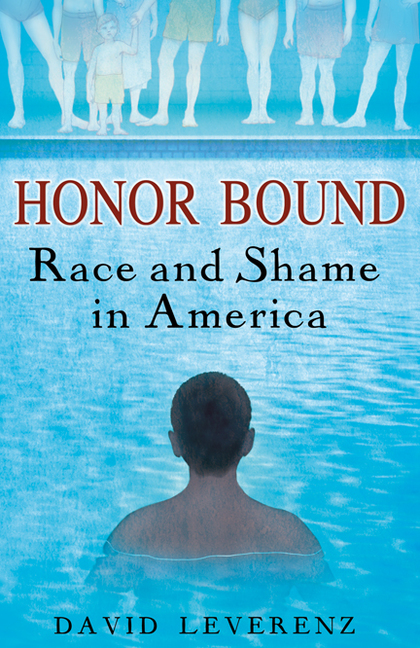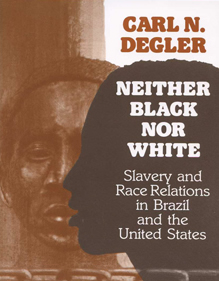Racial Paradise or Run-around? Afro-North American Views of Race Relations in Brazil
American Studies
Volume 46, Number 1 (Spring 2005)
pages 43-60
David J. Hellwig, Professor Emeritus of Interdisciplinary Studies
St. Cloud State University, St. Cloud, Minnesota
North American students of slavery and race relations have long used comparative approaches to examine the troubling phenomena of racial discrimination and violence in a society committed to democratic processes and equality. Implicit in these studies is the idea that understanding gained through a comparative perspective will facilitate action to reduce the gap between the ideals and the reality of North American life. Two societies in particular have been studied: South Africa and Brazil. While the example of South Africa has provided insight into aspects of North American culture deplored by most Americans, the example of Brazil has traditionally offered a positive model, one worthy of emulation.
Although people of African descent constitute a minority of the population, more Africans were brought to Brazil as slaves, slavery lasted longer, and today more black and brown people reside there than in any other Western Hemisphere nation. Despite the heritage of slavery, Brazil has traditionally been perceived by North Americans and white Brazilians as a social or racial democracy. According to the myth of the racial paradise, slavery was relatively mild in Brazil, relations between masters and bondsmen were softened by extensive miscegenation, slavery was ended without bloodshed, and since abolition in 1888, skin color has played little if any part in social stratification since. If there are relatively few dark-skinned Brazilians at the higher levels of society, it simply reflects disadvantages rooted in slavery. Above all, one finds no tradition of racial violence or of Jim Crow.
While the image of Brazil as a social democracy is still common in North America and even more so in Brazil, it has been seriously challenged since the end of World War II. In the 1950s UNESCO sponsored a thorough re-examination of Brazilian race relations by international teams of scholars. Though such international recognition reinforced the Brazilian elite’s belief in their racial democracy, in fact the studies did as much to undermine as to affirm the traditional image of Brazilian society. Studies done in the 1960s and 1970s by Brazilian scholars such as Florestan Fernandes, the Argentine-Brazilian Carlos Hasenbalg and the French sociologist Roger Bastide were even more critical of Brazil’s reputation as a society remarkably free of racism.
Black North Americans participated in the affirmation of the racial paradise myth until the mid-twentieth century, and in the contemporary attack upon it. Their critique was a product of the scholars’ re-examination of Brazil and reflected the greater knowledge of Latin America acquired through enhanced opportunities for formal study and travel there. More important, however, were black Americans’ domestic experiences following the gradual dissolution of Jim Crow after World War II and the resurgence of black nationalism in the late 1960s and 1970s.
Black Americans have observed that in contemporary Brazil, as in the U.S., dark-skinned people continue to constitute a disproportionate percentage of the poor and dispossessed despite repeated assurances by dominant groups of acceptance and advancement based on individual merit. Black people in both societies have been victims of arun-around: made promises and guaranteed rights but at the same time denied the education and financial resources needed to transform rights and opportunities into better jobs, housing and health care. Furthermore, given the low level of racial identity and unity among Afro-Brazilians, the likelihood of them altering their status within Brazilian society appears, if anything, even less likely than for black North Americans.
…The growing involvement of the United States in the world, along with the expansion of international trade and travel in the twentieth century, made black and white Americans more aware of Brazil and Latin America in general. One visit to South America, that of ex-President Theodore Roosevelt in 1913, was widely reported in the black and white press. The article Roosevelt wrote on “The Negro in Brazil” for the popular weekly Outlook in February, 1914, reinforced the prevalent image of race relations in Brazil. The Philadelphia Tribune was pleased to note that Roosevelt found colored professors in the state-supported schools, black and mulatto judges, extensive miscegenation, and no segregation or lynchings. His findings, it commented, were “of more than passing interest to us as a race” in highlighting the different treatment of the black race in Brazil and many other societies and in the United States. If wise, the United States would adopt the racial pattern existing in Brazil and avoid racial polarization and violence, the paper warned. A Chicago Defender editorial also praised Roosevelt’s article, telling readers “There is little or no prejudice in Brazil, therefore the problem, as we term it, is being solved in the only possible and effective way of solving it, by absorption, the intermarriage of the races a common occurrence, a man or woman being solely judged on their individual merit, upon their standing in life, the color of their skin playing little part.”
Throughout the 1910s, 1920s and 1930s the black American press continued to endorse a highly flattering assessment of race relations in Brazil. Leaders such as Booker T. Washington, Kelly Miller, W.E.B. DuBois and William Pickens agreed that Brazil offered people of color opportunities denied in the United States. J. A. Rogers in his classic 1924 history, From “Superman” to Man, also confirmed the traditional view. “In Brazil., .the Negro is taught not only to regard himself the equal of the white man, but he is given an opportunity to prove it. There is no walk of Brazilian life, official or unofficial, where he is not welcome and which he has not filled.” Rogers added that more than one Brazilian president had been of Negro descent, an observation often included in references to Afro- Brazilians. At least two articles published in the Journal of Negro History, Herbert B. Alexander’s “Brazilian and U.S. Slavery Compared” in 1922 and Mary W. Williams’ “The Treatment of Negro Slaves in the Brazilian Empire” in 1930, developed the thesis Frank Tannenbaum later popularized in his influential work Slave and Citizen that the status of Negroes in Brazil differed dramatically from the United States in large part because of the marked difference in the institution of slavery in the two societies…
…Nowhere was the trend of black Americans in the 1940s to question the existence of racial democracy in Latin America as apparent as in the comments of the premier black intellectual of the twentieth century, W.E.B. DuBois. His observations are especially instructive not only because of his status as a scholar and activist but because of the sharp change in his assessment of Brazilian race relations over the years. In the 1910s and 1920s DuBois expressed opinions shared by others regarding Brazil. The absence of a color bar and the absorption of the Negro race into the larger society without tension and violence testified to the baselessness of North American fears regarding race. It was important, he felt, for North Americans to challenge the view implicit in most books on Brazil that it was a white country and to read books such as The Conquest of Brazil by Roy Nash, a former Executive Secretary of the NAACP. This work, published in 1926, stressed both the presence of blacks in the nation’s history and the acceptability of race mixture in Brazil, DuBois noted.
In the 1930s DuBois said little if anything about Brazil. Early in the next decade, however, he reversed his previous position and presented a hard-hitting critique of Brazilian race relations and ideology. North American blacks “long pretended to see a possible solution in the gradual amalgamation of whites, Indians and blacks” in South America, he remarked. They “have grown used to being told the settlement of the Negro problem in Brazil is merely a matter of time and absorption: that if we shut our eyes long enough, a white Brazil. . . will emerge and Africa in South America disappear.” Such a belief was both unfounded and dangerous, DuBois now insisted. Racial amalgamation had meant neither “social uplift” nor greater power and prestige for mulattoes and mestizos in Latin America. While “dark blood” ran through the veins of many whites, dark people continued to experience social barriers, economic exploitation and political disfranchisement. White immigration was encouraged at all costs.
One deplorable consequence of the ideology of whitening was that many Afro-Brazilians no longer identified with their African ancestry. “Despite facts, no Brazilian… dare boast of his black fathers,” DuBois observed. The tendency of the “darker people” of the West Indies and South America to “think white” was so ingrained that they were losing awareness of their cultural patterns. In Brazil as elsewhere, people who knew themselves to be of Negro and Indian descent consented to their government presenting the nation to the world as “white” by appointing only Caucasians to diplomatic posts. To DuBois such behavior was a “tragic mistake” that would “tend to eliminate the darker races from the world because of a concerted rush and scramble on their part to become white.” In short, absorption of the Negro was not only biologically difficult, it was culturally and politically damaging for African people in South America and the world asa whole…
Read the entire article here.




